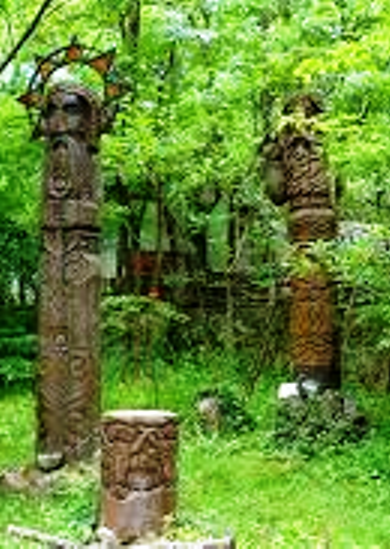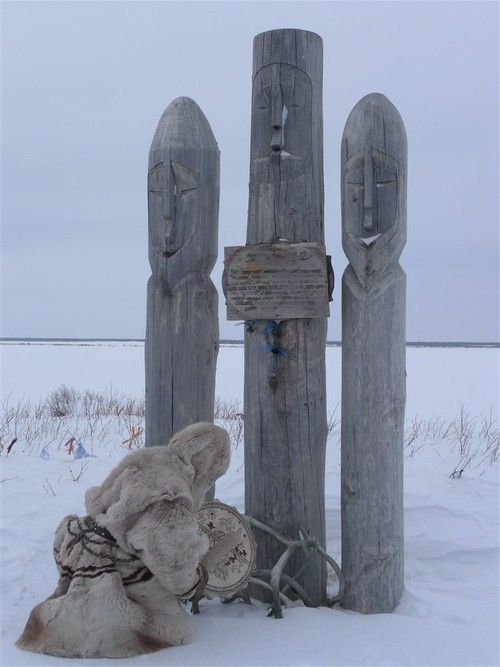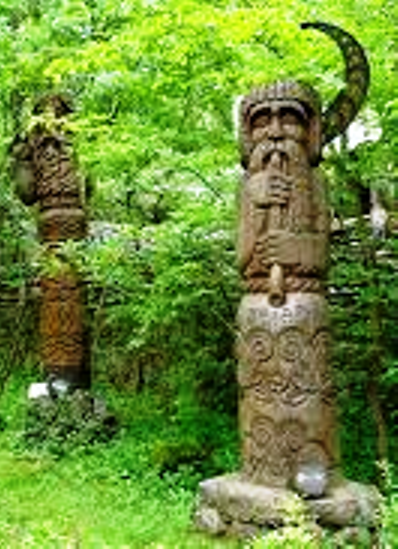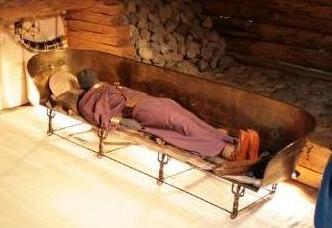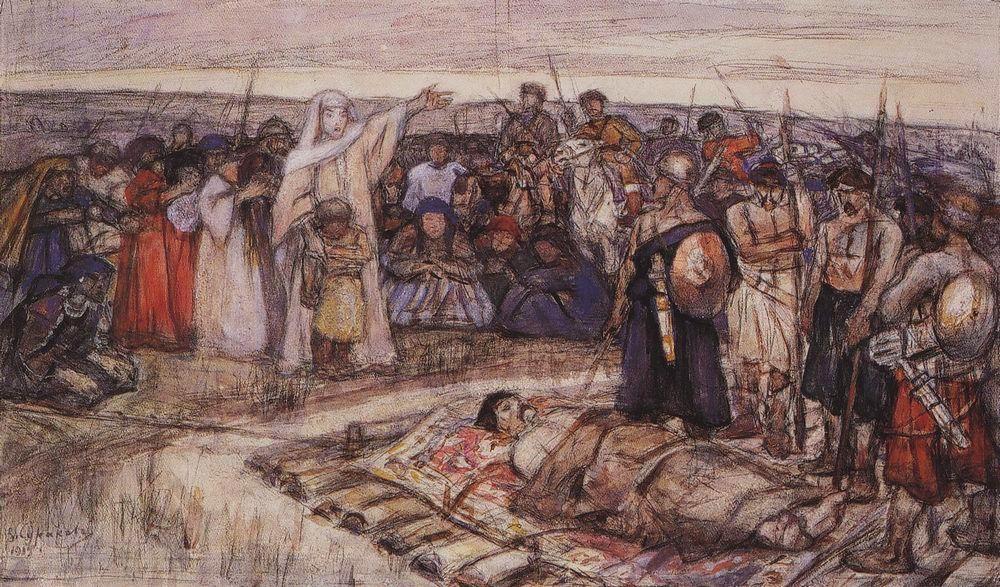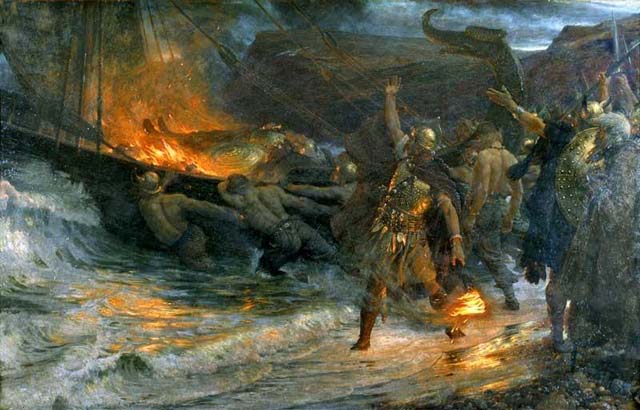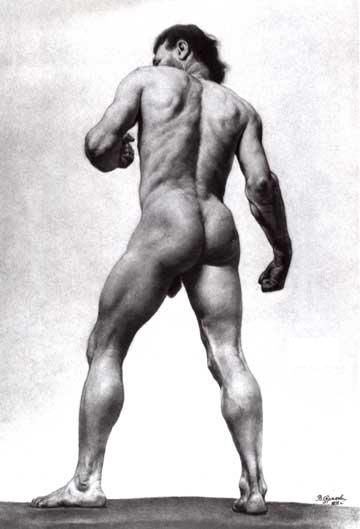of IBN FADLĀN
Translated by James E. MontgomeryThe Full Text was discovered in Turkey in 1923
Excerpt from IBN FADLĀN AND THE RŪSIYYAH by James E. Montgomery
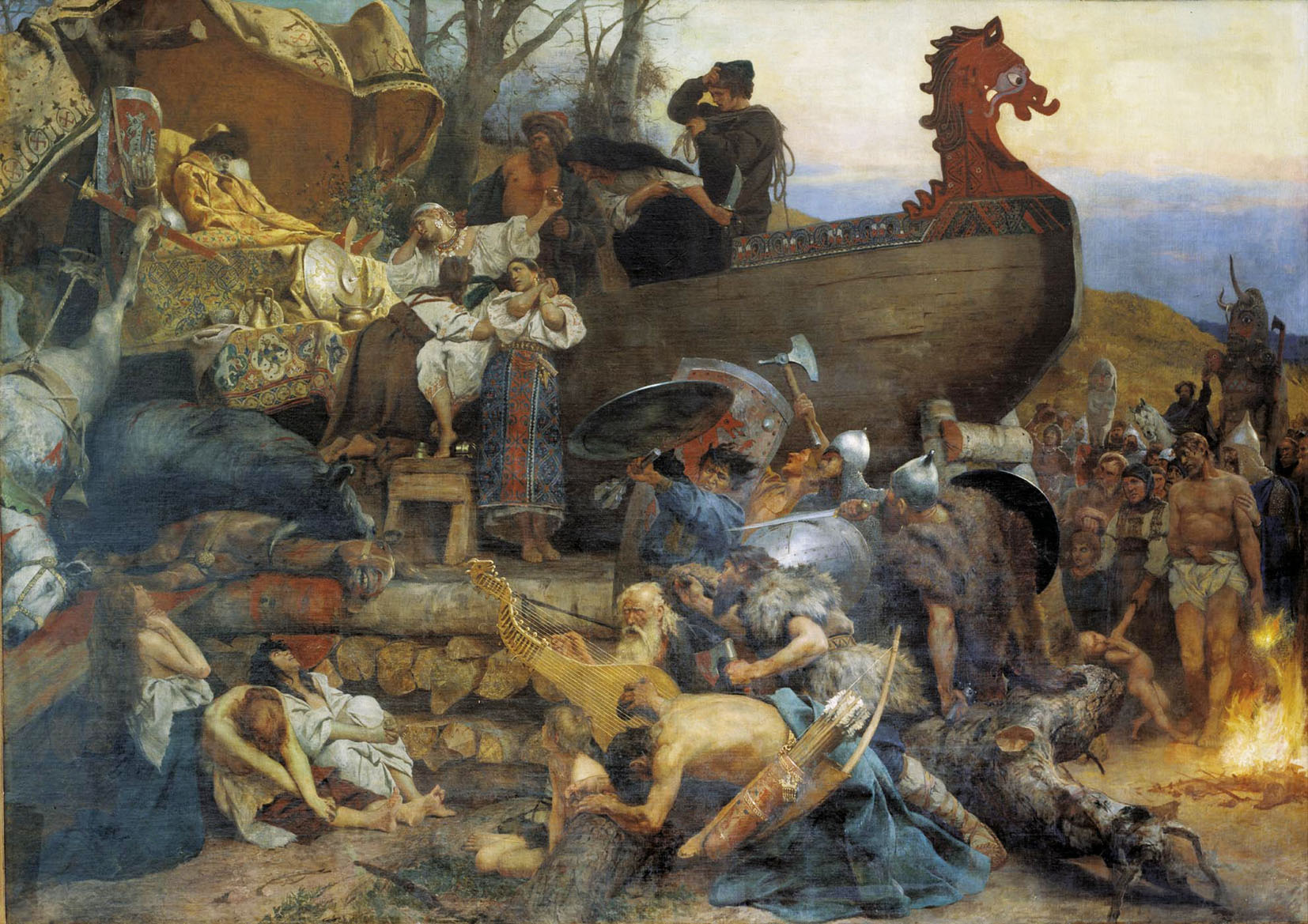
The Funeral of the Rus Chieftian
Henryk Siemiradzki 1884
|
The True Story of the 13th Warrior An Arab Travelogue describing Vikings on the Volga River, c. 10th century [HOME] |
||||
|
I saw the Rūsiyyah when they had
arrived on their trading expedition and had disembarked at the
River Ātil. I have never seen more perfect physiques than
theirs—they are like palm trees, are fair and reddish, and do
not wear the qurtaq
or the caftan. The
man wears a cloak with which he covers one half of his body,
leaving one of his arms uncovered. Every one of [6] them carries
an axe, a sword and a dagger and is never without all of that
which we have mentioned. Their swords are of the Frankish
variety, with broad, ridged blades. Each man, from the tip of
his toes to his neck, is covered in dark-green lines, pictures
and such like. Each woman has, on her breast, a small disc, tied
They are the filthiest of all Allāh’s
creatures: they do not clean themselves after excreting or
urinating or wash themselves when in a state of ritual impurity
(i.e., after coitus) and do not They arrive from their territory (min
baladi-him) and moor their boats by the
Ātil (a large river), building on its banks large wooden houses.
They [9] gather in the one house in their tens and twenties,
sometimes more, sometimes less. Each of them has a couch on
which he sits. They are accompanied by beautiful slave girls for
trading. One man will have intercourse with his slave-girl while
his companion looks on. Sometimes a group of them comes together
to do this, each in front of the other. Sometimes indeed the
merchant will come in to buy a slave-girl from one of them and
he will chance upon him having intercourse with her, but
The moment their boats reach this
dock every one of them disembarks, carrying bread, meat, onions,
milk and alcohol (nabīdh),
and goes to a tall piece of wood set up <in the ground> When one of them falls ill, they erect a tent away from them and cast him into it, giving him some bread and water. They do not come near him or speak to him, indeed they have no contact with him for the duration of his illness, especially if he is socially inferior or is a slave. If he recovers and gets back to his feet, he rejoins them. If he dies, they bury him, though if he was a slave they leave him there as food for the dogs and the birds. [12] If they catch a thief or a
bandit, they bring him to a large tree and tie a strong rope
around his neck. They tie it to the tree and leave him hanging
there until <the rope> breaks, I was told that when their chieftains
die, the least they do is to cremate them. I was very keen to
verify this, when I learned of the death of one of [13] their
great men. They placed him in his grave (qabr)
and erected a canopy over it for ten days, until they had
finished making and sewing his <funeral garments> [14] In the case of a poor man they
build a small boat, place him inside and burn it. In the case of
a rich man, they gather together his possessions and divide them
into three, one third for his family, one third to use for
When their chieftain dies, his family ask his slave-girls and slave-boys, “Who among you will die with him?” and some of them reply, “I shall.” Having said this, it becomes incumbent upon the person and it is impossible ever to turn back. Should that person try to, he is not permitted to do so. It is usually slave-girls who make this offer. When that man whom I mentioned
earlier died, they said to his slave-girls, “Who will die with
him?” and one of them said, “I shall.” So they placed [15] two
slave-girls in charge of her to take care of her and accompany
her wherever she went, even to the point of occasionally washing
her feet with their own hands. They set about attending to the
dead man, preparing his clothes for him and setting right all he
needed. Every day the slave-girl would drink On the day when he and the slave-girl
were to be burned I arrived at the river where his ship was. To
my surprise I discovered that it had been beached and that four
planks of birch (khadank)
and other types of wood had been erected for it. Around them
wood had been placed in such a way as to resemble scaffolding (anābīr).
Then the ship was hauled and placed on top of this wood. They
advanced, going to and fro <around the boat> |
||||
|
||||
| Then they
produced a couch and placed it on the ship, covering it with
quilts When they came to his grave, they removed the soil from the wood and then removed the wood, exhuming him <still dressed>
At the time of the evening prayer on Friday they brought the slave-girl to a thing that they had constructed, like a door-frame. She placed her feet on the hands of the men and was raised above that door-frame. She said something and they brought her down. Then they lifted her up a second time and she did what she had done the first time. They brought her down and then lifted her up a third time and she did what she had done on the first two occasions. They next handed her a hen. She cut off its head and threw it away. They took the hen and threw it on board the ship. [18] I quizzed the interpreter about her actions and he said, “The first time they lifted her, she said, ‘Behold, I see my father and my mother.’ The second time she said, ‘Behold, I see all of my dead kindred, seated.’ The third time she said, ‘Behold, I see my master, seated in Paradise. Paradise is beautiful and verdant. He is accompanied by his men and his male-slaves. He summons me, so bring me to him.’” So they brought her to the ship and she removed two bracelets that she was wearing, handing them to the woman called the “Angel of Death,” the one who was to kill her. She also removed two anklets that she was wearing, handing them to the two slave-girls who had waited upon her: they were the daughters of the crone known as the “Angel of Death.” Then they lifted her onto the ship but did not bring her into the pavilion. The men came with their shields and sticks and handed her a cup of alcohol over which she chanted and then drank. The interpreter said to me, “Thereby she bids her female companions farewell.” She was handed another cup, which she [19] took and chanted for a long time, while the crone urged her to drink it and to enter the pavilion in which her master lay. I saw that she was befuddled and wanted to enter the pavilion but she had <only> Six men entered the pavilion and all had intercourse with the slave-girl. They laid her down beside her master and two of them took hold of her feet, two her hands. The crone called the “Angel of Death” placed a rope around her neck in such a way that the ends crossed one another (mukhālafan) and handed it to two
 One
of the Rūsiyyah stood beside me and I heard him speaking to my
interpreter. I quizzed him about what he had said, and he
replied, “He said, ‘You Arabs are a foolish lot!’” So I said,
“Why is that?” and he replied, “Because you purposely take those
who are dearest to you and whom you hold in highest esteem and
throw them under the earth, where they are eaten by the earth,
by vermin and by worms, whereas we burn them in the fire there
and then, so that they enter Paradise immediately.” Then he
laughed loud and long. I quizzed him about that <i.e. entry into
Paradise> One
of the Rūsiyyah stood beside me and I heard him speaking to my
interpreter. I quizzed him about what he had said, and he
replied, “He said, ‘You Arabs are a foolish lot!’” So I said,
“Why is that?” and he replied, “Because you purposely take those
who are dearest to you and whom you hold in highest esteem and
throw them under the earth, where they are eaten by the earth,
by vermin and by worms, whereas we burn them in the fire there
and then, so that they enter Paradise immediately.” Then he
laughed loud and long. I quizzed him about that <i.e. entry into
Paradise> They built something like a round hillock over the ship, which they had pulled out of the water, and placed in the middle of it a large piece of birch (khadank) on which they wrote the name of the man and the name of the King of the Rūs. Then they left. He (Ibn Fadlān) said: One of the customs of the King of the Rūs is that in his palace he keeps company with four hundred of his bravest and most trusted companions; they die when he dies and they offer their lives to protect him. Each of them has a slave-girl who waits on him, washes his head and prepares his food and drink, and another with whom he has coitus. These four hundred |
